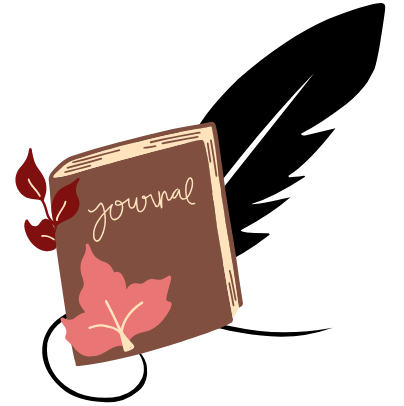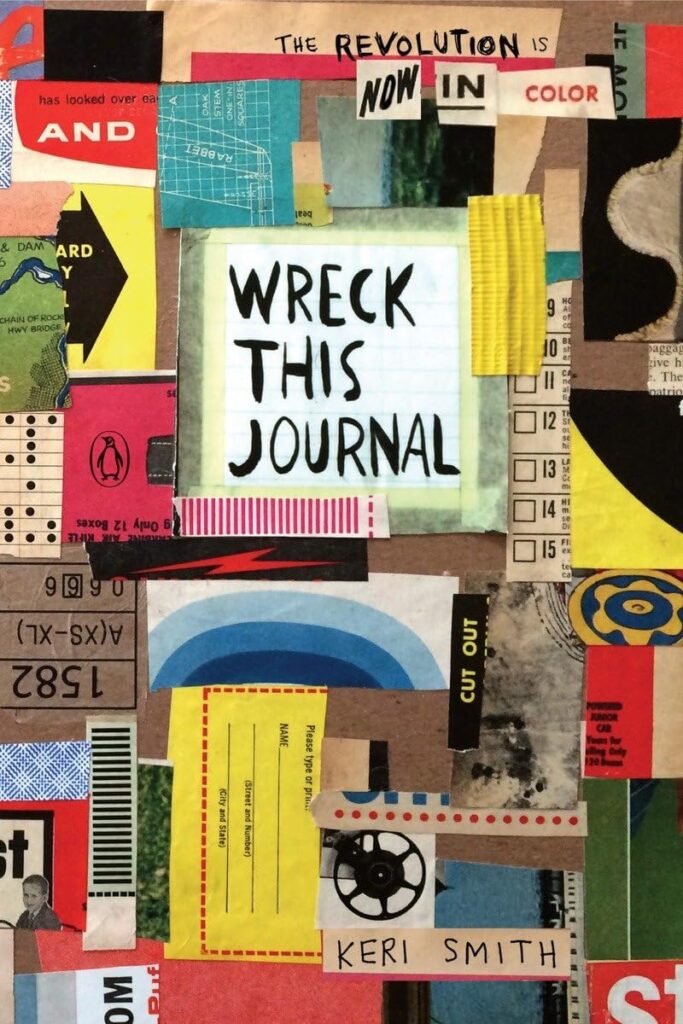I never thought I’d find myself pouring coffee on a book, ripping out pages, or dragging it through mud. But that’s exactly what I did when I uncovered “Wreck This Journal” by Keri Smith.
This unconventional art project turned my understanding of creativity upside down and opened up a whole new world of artistic expression.
Just a heads-up: This post contains affiliate links, meaning if you click and make a purchase, I may earn a small commission—at no extra cost to you. I only recommend products I genuinely believe can spark creativity and provide value.
Now, let’s dive into my review of Wreck This Journal and see why it’s a must-try for self-expression!
The Birth of Creative Destruction
Keri Smith, a Canadian artist and author, introduced “Wreck This Journal” in 2007. The concept is brilliantly simple: a book filled with over 100 prompts encouraging users to engage in acts of destruction.
Poke holes in pages, tear them out, get the book dirty – all the things we’ve been taught never to do to books.
The impact has been astounding. With over 2 million copies sold worldwide and translations into more than 30 languages, “Wreck This Journal” has sparked a creative revolution.
Breaking the Rules of Creativity
At it’s heart, “Wreck This Journal” challenges our deeply ingrained beliefs about art and creativity. We’re taught from a young age to keep books pristine, to color inside the lines, and to strive for perfection in our artistic endeavors.
This book throws all of that out the window.
Dr. Emma Thompson, a psychologist specializing in creativity, explains: “The fear of imperfection can be paralyzing for many people. By encouraging deliberate mistakes, this journal helps rewire our brains to see imperfection as a natural part of the creative process.”
The Psychology of Destruction
The power of “Wreck This Journal” comes from it’s ability to tap into several psychological principles:
1. Anti-Perfectionism
Perfectionism can be a major roadblock to creativity. By giving us permission to make mistakes and create “ugly” art, the journal frees us from the pressure of producing something flawless.
2. Mindfulness and Present-Moment Awareness
Many of the prompts in the journal need full attention and engagement with the physical world. This aligns closely with mindfulness practices, which emphasize being present in the moment as opposed to fixating on results.
3. Cognitive Flexibility
The unexpected and often contradictory nature of the prompts (e.g., “Glue random items to this page” followed by “Sew this page”) challenges our brains to think in new ways and make unusual connections.
4. Emotional Release
The act of destruction can be incredibly cathartic. Ripping, crumpling, or scribbling aggressively on pages provides a physical outlet for emotions that might otherwise stay bottled up.
Here’s a step-by-step guide to help you get started:
1. Start Small
Begin with less intimidating prompts. Try drawing with your non-dominant hand or coloring a page using only food items.
These exercises help you break away from perfectionism without feeling too overwhelmed.
2. Escalate Gradually
As you become more comfortable, tackle more destructive prompts. Tear out a page and throw it away.
Drip something on the paper.
Each act of destruction becomes easier, and you’ll likely find yourself becoming bolder in your choices.
3. Embrace Accidents
Spilled your coffee? Great!
Use it to create a unique pattern on the page.
Dropped the book in a puddle? Perfect – now you have an interesting texture to work with.
Learning to see accidents as opportunities is a crucial skill in both art and life.
4. Reflect on Your Reactions
Pay attention to how you feel as you work through the prompts. Are you anxious about ruining the book?
Excited by the freedom?
Frustrated by certain tasks? These emotions can provide valuable insights into your relationship with creativity and control.
5. Document Your Progress
Take photos or videos of your wrecking process. This serves two purposes: it allows you to see your progress over time, and it helps you appreciate the beauty in destruction.
You might be surprised by how visually interesting a crumpled, coffee-stained page can be.
Beyond the Book: Applying Creative Destruction
The principles of “Wreck This Journal” can be applied far beyond it’s pages. Here are some ways to incorporate creative destruction into various artistic disciplines:
Writing
- Cut up old manuscripts and rearrange the words to create new stories.
- Write a poem, then erase every other line to create a new piece.
- Type a story, then randomly delete words to see how it changes the meaning.
Visual Arts
- Paint over old canvases with new designs.
- Create a collage, then tear it apart and reassemble it.
- Take photographs, print them out, and physically alter them with scissors, paint, or other materials.
Music
- Record a melody, then play it backwards or at different speeds.
- Write lyrics, cut them up, and rearrange them randomly.
- Experiment with “breaking” traditional song structures.
Dance
- Choreograph a routine, then perform it in reverse.
- Improvise movements based on the act of destruction (tearing, crumpling, etc.).
- Collaborate with others to “interrupt” each other’s movements, creating a new dance in the process.
Overcoming Creative Blocks
One of the most powerful aspects of “Wreck This Journal” is it’s ability to help overcome creative blocks. By removing the pressure of creating something “good,” it frees us to create anything at all.
Sarah Chen, a graphic designer, shares her experience: “I was stuck on a project for weeks. Then I spent an hour with Wreck This Journal, and suddenly ideas were flowing again. The act of destruction somehow unlocked my creativity.”
This phenomenon can be explained by several factors:
- Lowered Stakes: When the goal is to “ruin” something, there’s no pressure to create a masterpiece.
- Increased Playfulness: The prompts encourage a childlike approach to creativity, bypassing our adult inhibitions.
- New Perspectives: Destruction forces us to see materials and ideas in new ways, sparking fresh connections.
- Physical Engagement: The tactile nature of many prompts engages different parts of our brain than traditional artistic methods.
The Transformation: From Destruction to Creation
As you become more comfortable with creative destruction, you’ll likely notice a shift in your overall approach to art and self-expression. This is where the real transformation begins.
Many users report:
- Increased confidence in their artistic abilities
- A greater willingness to take risks in their creative work
- A more playful approach to problem-solving in general
- Reduced anxiety about making mistakes
- Enhanced ability to see beauty in imperfection
These changes often extend beyond artistic pursuits, influencing how people approach challenges in their personal and professional lives.
Advanced Wrecking Techniques
Once you’ve mastered the basics of creative destruction, you can explore more advanced techniques:
1. Time Bomb Art
Set a timer for a short period (5-10 minutes) and create something as quickly as possible. When the timer goes off, immediately destroy your creation in some way.
This exercise helps combat perfectionism and encourages rapid idea generation.
2. Collaborative Destruction
Work with a friend or group to create and destroy art together. Pass a piece back and forth, each adding to or altering it in some way.
This can lead to unexpected collaborations and teaches the value of letting go of control.
3. Nature’s Wreck
Take your journal (or any artwork) outside and let nature “wreck” it. Leave it in the rain, bury it in sand, or expose it to sunlight for an extended period.
This technique connects your art to the natural world and introduces an element of chance.
4. Digital Destruction
Apply the principles of “Wreck This Journal” to digital art. Create an image or design, then use editing tools to deliberately glitch, distort, or corrupt the file.
This can lead to fascinating visual effects and challenges our ideas about permanence in the digital age.
5. Sensory Wrecking
Close your eyes and use different textures (sand, paint, fabric) to alter a page without looking. This exercise engages your other senses and can produce surprising results.
6. Emotional Destruction
Choose a prompt or create a piece of art based on a specific emotion (anger, joy, grief). Then, destroy or alter it in a way that represents the opposite emotion or the transformation of that feeling.
The Science Behind Creative Destruction
The effectiveness of “Wreck This Journal” and similar approaches to creativity isn’t just anecdotal. There’s scientific backing for why this method works:
Neuroplasticity
Engaging in novel and unexpected tasks, like those in the journal, promotes neuroplasticity – the brain’s ability to form new neural connections. This increased flexibility in thinking can lead to more creative problem-solving in all areas of life.
Stress Reduction
The act of destruction, when done in a controlled and purposeful way, can be a powerful stress reliever. It activates the body’s relaxation response, reducing cortisol levels and promoting a sense of calm.
Cognitive Reframing
By redefining destruction as a creative act, “Wreck This Journal” helps users practice cognitive reframing – the ability to look at situations from different perspectives. This skill is valuable in managing stress and approaching problems creatively.
Flow State
Many users report entering a “flow state” while working on the journal – a psychological state characterized by full immersion and enjoyment in the present moment. Flow states are associated with increased creativity and reduced anxiety.
Incorporating “Wreck This Journal” into Daily Life
To truly benefit from the principles of creative destruction, it’s helpful to incorporate them into your daily routine:
- Morning Pages: Start your day with a “wrecking” session. This can help clear your mind and set a creative tone for the day.
- Stress Relief: Keep your journal handy for moments of stress or anxiety. A quick destructive exercise can provide immediate relief.
- Problem-Solving: When faced with a challenging problem, try a wrecking exercise to approach it from a new angle.
- Creative Warm-Up: Use the journal as a warm-up before diving into other creative projects.
- Mindfulness Practice: Incorporate wrecking exercises into your mindfulness or meditation routine to enhance present-moment awareness.
Overcoming Resistance
Despite it’s benefits, many people initially resist the idea of intentionally destroying a book or artwork. Common concerns include:
- “It feels wasteful.”
- “I’m not creative enough for this.”
- “What’s the point of making something just to destroy it?”
These concerns are valid, but they often stem from deeply ingrained beliefs about creativity and value. Here’s how to address them:
- Reframe “Waste”: Think of the journal as a tool for learning and growth, not a finished product. It’s value comes from the process, not the end result.
- Start Small: If destroying an entire book feels overwhelming, start with a single sheet of paper or a digital file.
- Focus on the Benefits: Remind yourself of the stress relief, increased creativity, and personal insights that can come from this practice.
- Give Yourself Permission: Explicitly tell yourself it’s okay to make a mess, to create “bad” art, and to prioritize the process over the product.
The Ripple Effect: How Creative Destruction Impacts Other Areas of Life
The principles learned through “Wreck This Journal” often extend far beyond artistic pursuits. Users report:
- Increased Resilience: Learning to see destruction as part of the creative process helps build resilience in the face of setbacks.
- Enhanced Problem-Solving: The ability to approach problems from unconventional angles translates to improved problem-solving in work and personal life.
- Greater Emotional Intelligence: The reflective nature of many prompts can lead to increased self-awareness and emotional regulation.
- Improved Relationships: The lessons in letting go and embracing imperfection can lead to more compassionate and flexible interpersonal dynamics.
- Reduced Anxiety: As perfectionism decreases, many users report lower levels of general anxiety.
Final Thoughts
In conclusion, Wreck This Journal by Keri Smith is not just a book—it’s a creative journey that challenges you to let go of perfection and embrace the joy of messy self-expression.
Whether you’re looking to reignite your imagination, destress, or simply have fun, this interactive masterpiece will leave you inspired and craving more.
Ready to start your own adventure?
Frequently Asked Questions
What is “Wreck This Journal”?
“Wreck This Journal” is an interactive book created by artist Keri Smith. It contains prompts that encourage readers to engage in acts of creative destruction, challenging traditional notions of art and creativity.
How can destroying a book be considered art?
The artistic value of “Wreck This Journal” comes from the process of creation through destruction. It challenges users to think differently about art, creativity, and perfectionism.
Is “Wreck This Journal” suitable for children?
While the book is not specifically designed for children, many of the prompts can be adapted for younger users under adult supervision. It can be a great tool for teaching kids about creativity and overcoming perfectionism.
Can “Wreck This Journal” help with anxiety or stress?
Many users report that the activities in “Wreck This Journal” help reduce anxiety and stress by providing a physical outlet for emotions and promoting mindfulness.
Do I need artistic skills to use “Wreck This Journal”?
No artistic skills are required. The journal is designed for people of all skill levels and aims to break down barriers to creativity.
How long does it take to complete “Wreck This Journal”?
There’s no set timeframe for completing the journal. Some people work through it quickly, while others take months or even years.
The pace is entirely up to the person user.
Can I use “Wreck This Journal” techniques in other areas of my life?
Absolutely! The principles of creative destruction can be applied to various aspects of life, from problem-solving at work to managing personal relationships.
Is there scientific evidence supporting the benefits of creative destruction?
While research specifically on “Wreck This Journal” is limited, there are studies supporting the psychological benefits of creative activities, mindfulness, and cognitive reframing – all of which are elements of the journal’s approach.
Can “Wreck This Journal” help with writer’s block or other creative blocks?
Many users report that the journal helps overcome creative blocks by reducing pressure and encouraging a more playful approach to creativity.
Are there digital versions of “Wreck This Journal”?
While the physical book is the original and most popular format, there are digital adaptations available. However, many users find the tactile experience of the physical book to be an important part of the process.
Key Takeaways
- Creative destruction can unlock new levels of artistic expression and personal growth.
- Embracing imperfection leads to greater creative freedom and reduced anxiety.
- The act of letting go, both physically and mentally, can be a powerful tool for overcoming creative blocks and processing emotions.
- “Wrecking” techniques can be adapted to various art forms and creative processes, extending beyond the journal itself.
- The skills learned through creative destruction often translate to increased confidence and innovative thinking in other areas of life.





